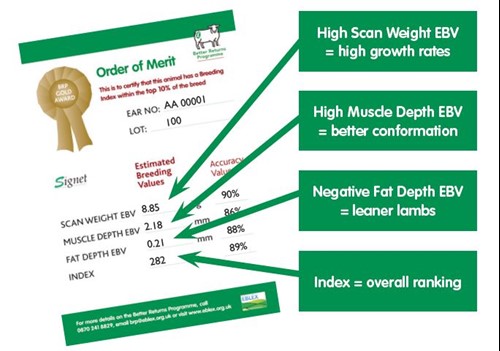Interpreting EBVs and Indexes

Understanding Estimated Breeding Values
 Pedigree and performance data is analysed to calculate how much of each animal’s performance is due to its breeding merit and how much is due to the environment in which it has been raised. This assessment of breeding potential is expressed as Estimated Breeding Values or EBVs.
Pedigree and performance data is analysed to calculate how much of each animal’s performance is due to its breeding merit and how much is due to the environment in which it has been raised. This assessment of breeding potential is expressed as Estimated Breeding Values or EBVs.
Estimated Breeding Values (EBVs) provide a measure of the breeding potential of an animal for a specific trait. They take into account performance data collected on known relatives, the relationships between performance traits (correlations) and the degree to which traits are inherited from one generation to the next (heritabilities).
EBVs are expressed in the same units as the recorded trait (e.g. kg for eight week weight) and they relate to a common baseline. This baseline of zero relates to the average breeding value of lambs born in the year when the within-flock or across-flock analysis was first produced.
EBVs are easy to interpret, for example: A ram with an EBV of +6 for scan weight is estimated to have the genetic potential to be 6kg heavier at 20/21 weeks compared to one with an EBV of 0.
A recorded ram will only pass on half of its genes to its lambs so its EBVs must be halved in order to estimate the average genetic worth of its progeny.
Which Estimated Breeding Values are readily available?
The following EBVs are produced for Signet clients:
| EBV | Trait | Raw Data |
| Litter Size | Prolificacy | This trait is defined as the total number of lambs born alive and dead when pregnancy reaches full term. |
| Maternal Ability (kg) | Maternal ability of ewe, relates to milk production | The component of a lamb’s growth to eight weeks of age that is influenced by the ewes breeding potential for milk production |
| Eight Week Weight (kg) | Growth rate to eight weeks of age. Maternal ability of ewe Weight at eight weeks of age. | To achieve an adjusted eight week weight lambs must be weighed between 42 and 84 days of age |
| Scan Weight (kg) | Growth rate to 21 weeks of age | Weight at scanning time, when lambs are 21 weeks of age |
| Muscle Depth (mm) | Carcase muscling | Measured at 21 weeks of age by a Signet-approved technician. Ultrasound measurements at the third lumbar vertebra |
| Fat Depth (mm) | Leanness | Measured at 21 weeks of age by a Signet-approved technician. Three ultrasound measurements taken at the third lumbar vertebra |
| Mature Size (kg) | Ewe efficiency | Ewe liveweight at first mating(kg) |
Further breeding values are now available for a range of traits derived from CT scanning, the assessment of parasite burden or data relating to maternal performance, such as lamb survival and longevity.
Breeding Indexes
While EBVs aid the selection of breeding stock for specific traits they can also be combined into breeding indexes.
Each trait is weighted within the index according to its economic importance in meeting a specific breeding objective or set of objectives.
The breeding index produced helps breeders to rank sheep.
The Sheepbreeder Service produces several different indexes, including a Terminal Sire Index, Maternal Index and Hill Index.